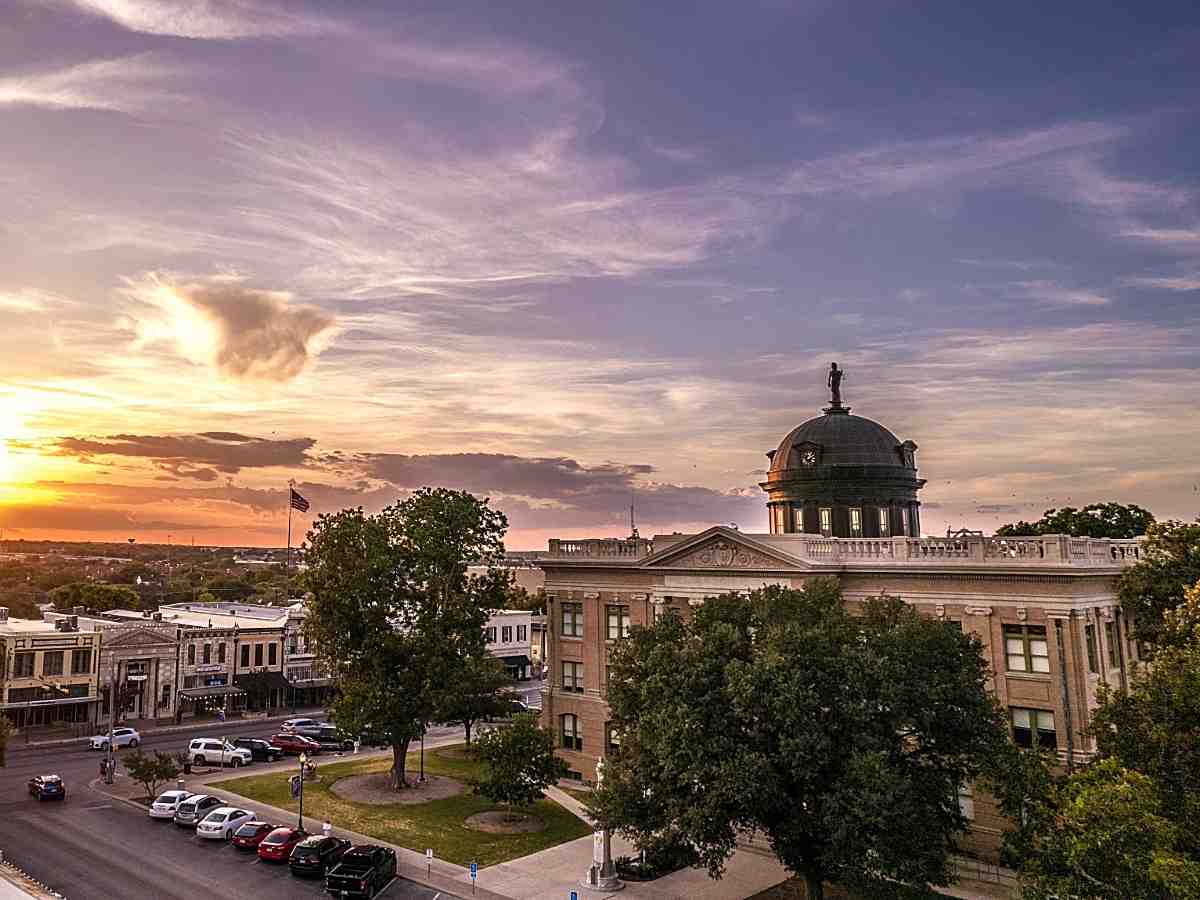For those considering relocating to Austin or Austin suburbs, Georgetown, Texas offers a unique opportunity. Once considered a sleepy town, Georgetown has quickly become a desirable option for those seeking a balance between small-town charm and proximity to the bustling Austin metro area. Located just 30 miles north of downtown Austin, Georgetown provides an alternative to the fast-paced lifestyle of Austin, with easy access to the city’s amenities while offering a slower pace of life and a bit more space.
This Austin suburb has transformed over the years, and its location, natural beauty, and abundant amenities make it an excellent choice for anyone looking to move to Central Texas.
The Allure of Georgetown’s Historic Downtown
A major draw for newcomers moving to Georgetown is its picturesque, historic downtown. The heart of the city is the Square, which boasts a beautifully preserved 100+ year-old courthouse, surrounded by a charming collection of shops, restaurants, and local businesses. Known for its vintage architecture and small-town ambiance, the Square is a must-see for anyone visiting the city or considering relocating here.
Notably, the Williamson County Courthouse Historic District, which encompasses much of the area, was added to the National Register of Historic Places in 1977. As a result, the Square is both a community hub and a point of pride for residents. Whether you’re dining at one of the many local restaurants, sipping wine at a local vineyard, or browsing through boutiques and antique shops, there’s something for everyone in Georgetown’s vibrant downtown.
The Perfect Blend of Country Living and City Proximity
One of the most appealing aspects of Georgetown, Texas is the opportunity for a more spacious lifestyle. Unlike the dense housing developments commonly seen in larger cities, this area offers several neighborhoods with expansive one-acre lots, particularly on the west side of town. These properties provide room for outdoor activities, gardening, and larger homes, all within a short drive of the city’s center.
For families, this Austin suburb is ideal for those seeking a little more space, peace, and quiet, but still want to be close enough to Austin to enjoy the amenities and work opportunities the city offers. Many of these homes also feature desirable amenities like panoramic views of the Hill Country, private water districts, and homes built by local custom builders. Prices for these one-acre homes typically start at around $325,000, with resale options available for less.
As more people choose to move to here, it’s important to note that while some of these properties are not connected to the city’s sewer system and rely on modern septic systems, this has not been a major deterrent for most residents. These homes tend to offer a reduced property tax bill since they are outside the city limits. For many, the benefit of owning more land and living a little farther from the city outweighs the minor inconvenience of maintaining a septic system.
Sun City: A Community for Retirees
Georgetown is also home to one of the largest age-restricted communities in Central Texas: Sun City, Texas. This 5,000+ acre community caters to residents aged 50 and over, offering a lifestyle tailored to retirees. Sun City was originally met with some resistance by Georgetown residents who feared that the community would impact the city’s youthful image. However, Sun City now accounts for over a third of the area’s total population, making it an integral part of the city.
Sun City is designed with active retirees in mind, offering golf courses, walking trails, swimming pools, and a range of social clubs and activities. For those considering relocating to Georgetown for retirement, this community offers a peaceful and social environment that allows residents to live independently while enjoying the company of like-minded neighbors.
Outdoor Living and Recreational Opportunities
Another advantage of relocating to Georgetown, Texas is the city’s proximity to nature and outdoor recreational activities. This Austin suburb is home to Lake Georgetown, a scenic 1,200-acre lake perfect for boating, fishing, kayaking, and hiking. There are also numerous parks and trails that surround the lake, making it an ideal location for outdoor enthusiasts. Many of the neighborhoods around the lake feature homes with views of the water or the surrounding Hill Country, adding to the appeal of this location for those who love nature.
For those looking for a bit more adventure, Inner Space Cave, located south of the city, is a popular tourist destination. This fascinating limestone cave system features unique karst formations and offers guided tours to explore the underground beauty of the area.
Georgetown’s Growth and Future
Georgetown, Texas has experienced steady growth, especially since the construction of Interstate 35, which runs through the city and connects this Austin suburb to Austin. Though it hasn’t seen the rapid expansion that cities like Round Rock have, the city continues to attract new residents looking for a quieter lifestyle with easy access to Austin.
The city’s population has steadily increased as more people seek an alternative to the rapid growth and high cost of living in Austin. Georgetown offers a more affordable option for those who want to live near the city but with the added benefit of more space, larger homes, and lower property taxes.
The addition of major highways and arterial routes leading to Austin has made commuting between the two cities even easier. Many residents of the area work in Austin but prefer to live in the more peaceful surroundings of their hometown. With its unique combination of rural charm and urban convenience, this city is quickly becoming a prime choice for those relocating to Austin and the surrounding areas.
A Rich History and Bright Future
Georgetown’s rich history and cultural significance have shaped the city into what it is today. Settlers were originally drawn to the area for its fertile soil and natural resources, and the city was named after George Washington Glasscock, who donated land for its founding. Since being named the county seat of Williamson County in 1848, Georgetown has grown from a small farming town into a thriving city.
The city’s continued development and the expansion of nearby Austin make Georgetown an appealing option for those moving to the area. It’s unique blend of historical charm, modern amenities, and proximity to Austin ensures that it remains a top choice for newcomers.
Georgetown: The Ideal Austin Suburb for Newcomers
For newcomers relocating to Austin, Georgetown is an excellent option to consider. It offers a more laid-back lifestyle with all the conveniences of being near a major metropolitan area. Whether you’re seeking more space, a slower pace of life, or just a more affordable alternative to Austin, this Austin suburb provides a compelling reason to make it your new home.
From its historic downtown square to its spacious neighborhoods and outdoor recreational options, this city offers a little something for everyone. With ongoing growth and development, the city is only poised to become an even more attractive destination for newcomers to the Austin metro area.
If you’re considering moving to Austin or relocating to Central Texas, Georgetown should definitely be on your radar. This Austin suburb offers an ideal blend of rural charm, modern amenities, and proximity to one of the most vibrant cities in the country. Whether you’re starting a family, retiring, or looking for a place to settle down in Central Texas, Georgetown is a place to call home.
Request your free Austin Relocation Guide here




